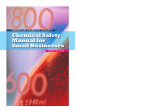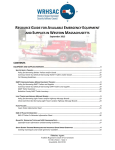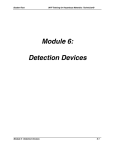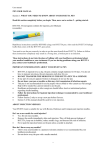Download Byetta - Massachusetts General Hospital
Transcript
Byetta Byetta helps stimulate the pancreas to release insulin in response to high blood sugars. Byetta should be injected, one hour before the two main meals, approximately 6-hours apart. This medication must be injected. Your health care provider will teach you how to prepare and inject properly. Possible side effects: Nausea, vomiting, diarrhea, feeling jittery, and upset stomach may occur as your body adjusts to the medication. Nausea usually lessens as you continue to use Byetta. When to stop Byetta temporarily: Severe and persistent abdominal pain, nausea, vomiting or diarrhea. Call your health care professional as these may symptoms of a more serious health condition. How to Use Your BYETTA® (exenatide) injection Pen Use these instructions as a quick reference to help you set up a new pen and then use it for your daily doses. See the User Manual that is included with your BYETTA Pen for more complete instructions. These instructions are the same for both the 5-mcg pen and the 10-mcg pen. ONE-TIME-ONLY NEW PEN SETUP ROUTINE USE Set up your new pen just before you use it the first time. For routine use, do not repeat this one-time-only new pen setup. If you do, you will run out of BYETTA before 30 days of use. Now that you have done the one-time-only new pen setup, follow steps below for all of your injections. STEP A STEP 1 Check the Pen Check the Pen Note: A small air bubble in the cartridge is normal. • Wash hands prior to use. • Check pen label to make sure • Check BYETTA in the cartridge. STEP B outer needle shield. • Push outer needle shield containing the needle straight onto the pen, then screw needle on until secure. STEP 2 • Pull off outer needle shield. Do not throw away. •Pull off inner needle shield and throw away. A small drop of liquid may appear. This is normal. outer needle shield. • Push outer needle shield containing the needle straight onto the pen, then screw needle on until secure. STEP 3 • Pull dose knob out until is in the dose window. If not, turn dose it stops and the is in the knob away from you (clockwise) dose window. until it stops and the is in the dose window. The liquid should be clear, colorless, and free of particles. If not, do not use. • Turn dose knob away from you until it stops at or . Make sure that the 5 or 10 with the line under it is in the center of the dose window. Attach the Needle • Remove paper tab from Dial the Dose • Check that the • Check BYETTA in the cartridge. it is your 5- or 10-mcg pen. • Pull off the blue pen cap. Attach the Needle • Remove paper tab from STEP C • Wash hands prior to use. • Check pen label to make sure The liquid should be clear, colorless, and free of particles. If not, do not use. it is your 5- or 10-mcg pen. • Pull off the blue pen cap. Note: A small air bubble will not harm you or affect your dose. • Pull off outer needle shield. Do not throw away. • Pull off inner needle shield and throw away. A small drop of liquid may appear. This is normal. Dial the Dose • Pull dose knob out until •Check that the is in the it stops and the is in the dose window. If not, turn dose knob away from you (clockwise) dose window. until it stops and the is in the dose window. • Turn dose knob away from you until it stops at or . Make sure that the 5 or 10 with the line under it is in the center of the dose window. Note: If you cannot turn the dose knob away from you to the or , see the ”Commonly Asked Questions” section of the User Manual that comes with your BYETTA Pen. Note: If you cannot turn the dose knob away from you to the or , see the ”Commonly Asked Questions” section of the User Manual that comes with your BYETTA Pen. STEP D STEP 4 Prepare the Pen Inject the Dose 5 5 seconds seconds • Point the needle of the pen up and away from you. PUSH & HOLD • Use thumb to firmly push injection button in until it stops, then continue holding the injection button in while slowly counting to 5. • If you do not see a stream or several drops come from the needle tip, repeat Steps C & D. • Pen preparation is complete when the is in the center of the dose window AND you have seen a stream or several drops come from the needle tip. • Grip pen firmly. • Insert needle into skin using the under-the-skin (subcutaneous) injection method explained by your healthcare professional. PUSH & HOLD •Use thumb to firmly push injection button in until it stops. Continue holding the injection button while slowly counting to 5 to get a full dose. •Remove needle from skin. • Injection is complete when the is in the center of the dose window. • The pen is now ready to be reset. Note: If you do not see liquid after 4 times, see Section 2 of the Patient Education Booklet, All About BYETTA. Note: If you see several drops of BYETTA leaking from the needle after the injection, you may not have received a complete dose. See BYETTA Pen Information on reverse side. STEP E STEP 5 Complete New Pen Setup • For routine use, do not repeat this one-time-only new pen setup. If you do, you will run out of BYETTA before 30 days of use. • You are now ready for your Reset the Pen • Turn dose knob away from you until it stops and the is in the dose window. first dose of BYETTA. • Go to Step 3 of Routine Use for instructions on how to inject your first routine dose. • Turn dose knob away from you until it stops and the is in the dose window. STEP 6 Note: If you cannot turn the dose knob, or if your pen leaks, your full dose has not been delivered. See Section 2 of the Patient Education Booklet, All About BYETTA. Remove and Dispose of the Needle Note: If you cannot turn the dose knob, see the ”Commonly Asked Questions” section of the User Manual that comes with your BYETTA Pen. • Carefully put the outer needle shield back over the needle. • Remove the needle after each injection. STEP 7 • Unscrew the needle. •Replace blue cap on pen before storage. • Throw away needles in a puncture-resistant container or as recommended by your healthcare professional. Store Pen for Next Dose • Store your BYETTA Pen properly. (See BYETTA Pen Information on reverse side.) • When it is time for your next routine dose, repeat Steps 1–7. MEDICAL WASTE New Information About Disposing of Medical Sharps The Coalition for Safe Community Needle Disposal, comprised of medical, government and waste association and private sector companies, is working with the Environmental Protection Agency to evaluate and promote alternative disposal methods for used needles and other medical sharps. Improper management of discarded needles and other sharps can pose a health risk to the public and waste workers. For example, discarded needles may expose waste workers to potential needle stick injuries and potential infection when containers break open inside garbage trucks or needles are mistakenly sent to recycling facilities. Janitors and housekeepers also risk injury if loose sharps poke through plastic garbage bags. Used needles can transmit serious diseases, such as HIV and hepatitis. The Coalition has identified several types of safe disposal programs for self- injectors. Instead of placing sharps in the trash, self-injectors are encouraged to use any of these alternative disposal methods • Drop Box or Supervised Collection Sites Sharps users can take their own sharps containers filled with used needles to appropriate ollections sites: doctors' offices, hospitals, pharmacies, health departments, or fire stations. Services are free or have a nominal fee. Check with your pharmacist or other health care provider for availability in your area. • Mail-back Programs Sharps users place their used sharps in special containers and return the container by mail to a collection site for proper disposal. This service usually requires a fee. Fees vary, depending on the size of the container. Check with your health care provider, pharmacist, yellow pages, or search the Internet using keywords "sharps mail back." • Syringe Exchange Programs (SEP) Sharps users can safely exchange used needles for new needles. Contact the North American Syringe Exchange Network at 253-272-4857 or online at <www.nasen.org>. • At-home Needle Destruction Devices Several manufacturers offer products that allow you to destroy used needles at home. These devices sever, burn, or melt the needle, rendering it safe for disposal. Check with your pharmacist or search the internet using keywords "sharps disposal devices." The prices of these devices vary according to product type and manufacturer. For More Information: • • • • Call your local solid waste department or public health department to determine the correct disposal method for your area. Ask your health care provider or local pharmacist if they offer disposal, or if they know of safe disposal programs in the area. Contact the Coalition for Safe Community Needle Disposal at 1-800-643-1643 Ask about the availability of safe disposal programs in your area or for information on setting up a community disposal program. Visit www.epa.gov/epaoswer/other/medical. This website also offers a list of all state health and solid waste/sanitation department contacts. Visit the Safe Community Needle Disposal web site. This easy-to-use website is designed for anyone interested in safe needle disposal. It provides state-by-state and territory-by-territory summaries of the laws and regulations affecting the labeling, transportation, and disposal of used needles and other sharps in the community. Needle Disposal Locations ** For additional locations please visit www.safeneedledisposal.org** Brewster Fire Department 1657 Main St Brewster, MA 02631 (508) 896-7018 Bourne Fire and Rescue 130 Main St Buzzards Bay, MA 02532 (508) 759-4112 West County Physicians 25 Health Stage Terrace Charlemont, MA 01339 (413) 772-2438 Barnstable County Hazardous Materials Program 64 High St Cotuit, MA 02635 (508) 428-2210 Barnstable County Hazardous Materials Program 2520 State Hwy Eastham, MA 02642 (508) 255-2324 Franklin County Solid Waste Management 50 Miles Street Greenfield, MA 01301 (413) 772-2438 Walgreen’s Pharmacy 210 Main St Haverhill, MA 01830 (978) 521-4671 New Salem Town Nurse 15 South Main St New Salem, MA 01355 (413) 772-2438 Cambridge Needle Exchange 17 Sellers St Cambridge, MA 02139 (617) 599-0219 Tapestry Health Needle Exchange 16 Center St Northampton, MA 01060 (413) 586-0310 P A T I E N T I N F O R M A T I O N Flying With Diabetes Having diabetes shouldn’t stop you from traveling. But taking a few precautions can help you have a safer and more relaxed trip, especially if you take insulin. Plan Ahead See your diabetes care provider 4–6 weeks before taking a long trip so you will have enough time to work on your diabetes control. Bring a copy of your itinerary, showing arrival and departure times, flight durations, and time zone changes to help determine whether you need to change your insulin or pill regimen when crossing time zones. Get any immunizations you need at least a month early. Ask for extra prescriptions in case you lose your medicines while traveling. Pack Wisely Keep diabetes supplies in a carry-on bag. This will keep you from losing them if checked luggage is lost and will protect them from extreme temperatures that could reduce their effectiveness. Pack insulin vials between layers of clothing or wrapped in something soft. Airport X-ray machines won’t hurt your glucose meter, insulin, or insulin pump. If you have concerns, ask to have your carry-on bags hand-inspected. Know the Rules You can bring syringes and insulin delivery systems on a plane only if a vial of insulin is presented with a professional, preprinted pharmaceutical label that clearly identifies the medication. Bring the original insulin box, which usually displays the label. Lancets must be capped and brought aboard with a glucose meter that has the manufacturer’s name printed on it. Keep glucagon kits in their original containers that show a preprinted pharmaceutical label. don’t match the type of insulin you use will draw up the wrong amount. Take More, Not Less Take two blood glucose monitors (packed in separate bags) and more than enough supplies—perhaps an extra 2 weeks’ worth. This includes insulin, test strips and lancets, glucose meter batteries, and insulin pump supplies if you use one. Consider carrying rapid-acting insulin, even if you don’t usually use it, to treat high blood glucose or manage any sick days. Take a glucagon kit, other prescription medicines you need, and medicines for vomiting and diarrhea. Teach travel companions how to administer glucagon in case you have severe hypoglycemia. Wear a Medic Alert bracelet or necklace that shows you have diabetes and use insulin. Inject Insulin Safely Airplane cabins are pressurized. Before using a syringe in flight, remove and replace the plunger to allow pressure equalization. If you are traveling across several time zones, you may need to change the timing and amount of your insulin doses. When you travel eastward, days become shorter, so you may need less insulin than usual. Traveling westward, days become longer, so you may need more insulin than usual. Your diabetes care provider can recommend adjustments to your regimen. While flying, keep your wristwatch set to the time where you embarked. This will help you remember when to take your insulin. Change your watch to local time the morning after you arrive at your destination. Eat, Drink, and Be Healthy Carry glucose tablets, gels, or candy to relieve symptoms of hypoglycemia and snacks such as breakfast bars, crackers, or trail mix for missed or delayed meals. Call your airline at least 2 days in advance to request meals that are low in sugar, fat, and cholesterol. Keep yourself well hydrated while flying by drinking nonalcoholic, caffeine-free beverages. Check your blood glucose at least every 4–6 hours. Don’t take premeal insulin until your meal is placed in front of you. Protect Your Medicines In tropical locations, refrigerate your insulin as soon as possible. If refrigeration is not available, a wide-mouthed insulated non-breakable bottle or thermos can keep your insulin at a safe temperature. Fill the container with cold water or ice to cool it, then pour out the water or ice, put the insulin vials inside, and place the cap on securely. Never freeze insulin. Keep pills dry to avoid moisture damage. Know What To Expect Abroad In the United States, “U-100” insulin and syringes are used. But other countries may have “U-40” or “U-80” insulin and syringes. If you need to buy insulin abroad, remember that you’ll need U-40 syringes for U-40 insulin or U-80 syringes for U-80 insulin. Syringes that Permission is granted to reproduce this material for nonprofit educational purposes. Written permission is required for all other purposes. 3/03


















